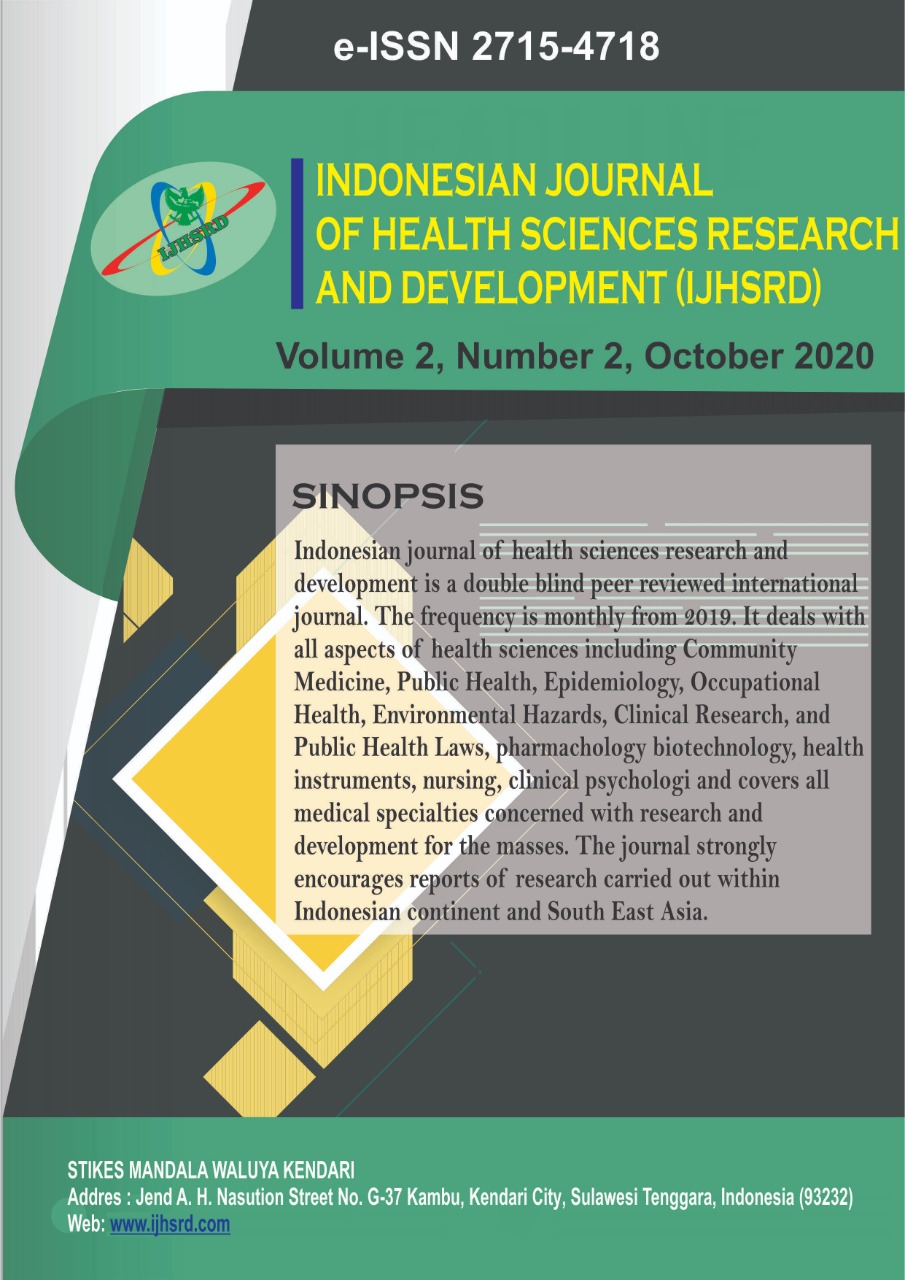Main Article Content
Abstract
Background: Mother who giving exclusive breast feeding in North Buton District was less than others in Nourt Buton District. This study investigated the risk factors of giving exclusive breastfeeding and non-exclusive breastfeeding for 0-6 month old babies’ nutritional status in Kulisusu primary health care in North Buton District.
Methods: This study was quantitative study which used a Case Control study design. Data analysis used independen t-test. This study recruited 82 mothers who had under 6 months old babies. This study was conducted in Kulisusu Primary Health Care area, in North Buton, Southeast Sulawesi province, Indonesia.
Result: The resuld found that there was significant differences of nutritional status between babies who gave exclusive breastfeeding and non-exclusive breastfeeding for 0-6 months old babies (p value =0,001 < 0,05).
Conclusion: This study suggested for health workers and community health volunteers to give motivate for mothers in order to give exclusive breastfeeding for their babies aged under 6 months. The primary health care must promote about benefits of exclusive breastfeeding for babies’ health and their growth.
Keywords
Article Details

This work is licensed under a Creative Commons Attribution-ShareAlike 4.0 International License.
References
- Health Department in Southeast Sulawesi Province. Profile of health in Southeast Sulawesi Province in 2017. Kendari: Health Department in Southeast Sulawesi Province; 2018.
- Health Department of North Buton. Health profile of North Buton District in 2017. Burunga: Health Department of North Buton; 2018.
- World Health Organization. Global strategy for infant and young child feeding. Geneva: World Health Organization; 2003.
- Pane HW, Tasnim T, Sulfianti, Hasnidar, Puspita R, Hastuti P, et al. Gizi dan Kesehatan. Medan: Yayasan Kita Menulis; 2020.
- Victora CG, Bahl R, Barros AJD, França GVA, Horton S, Krasevec J, et al. Breastfeeding in the 21st century: epidemiology, mechanisms, and lifelong effect. The Lancet. 2016;387(10017):475-90.
- Fitri DI, Chundrayetti E, Semiarty R. The relationship between giving breastmilk and growth in six months old babies in Naggalo Primary Health Care. Jurnal Kesehatan Andalas. 2014;3(2):136 - 9.
- Kertamuda MA. Golden age: the sucsessful strategy to build golden characters for early age children. Jakarta: PT. Elex Media Koputindo; 2015.
- Suradi R. Biology specification of breastmilk. Sari Pediatri. 2001;3(3):125 - 9.
- Tasnim T. Determinants of malnutrition in children under five years in developing countries: A systematic review. Indian Journal of Public Health Research & Development. 2018;9(6):333 - 8.
- Abdalla MA, Sulieman SA, El Tinay AH, Khattab AGH. Socio-economic aspects influencing food consumption patterns among children under age of five in rural area of Sudan. Pakistan Journal of Nutrition. 2009;8(5):653-9.
- Tasnim T, Lusida MI. The model of supervision for impermanent food sellers by women volunteer in Kendari City Indonesia. Indian Journal of Public Health Research & Development. 2018;9(10):209-14.
- Tasnim T. Community-led health planning model for village health team: A case study in Indonesia. Indonesian Journal of Health Sciences Research and Development. 2020;2(1):27-32.
- Tasnim T, Mwanri L, Dasvarma G. Mother's child feeding knowledge and practices associated with underweight in children under-five years: A study from rural Konawe, Indonesia. Public Health of Indonesia. 2018;4(1):9-18.
